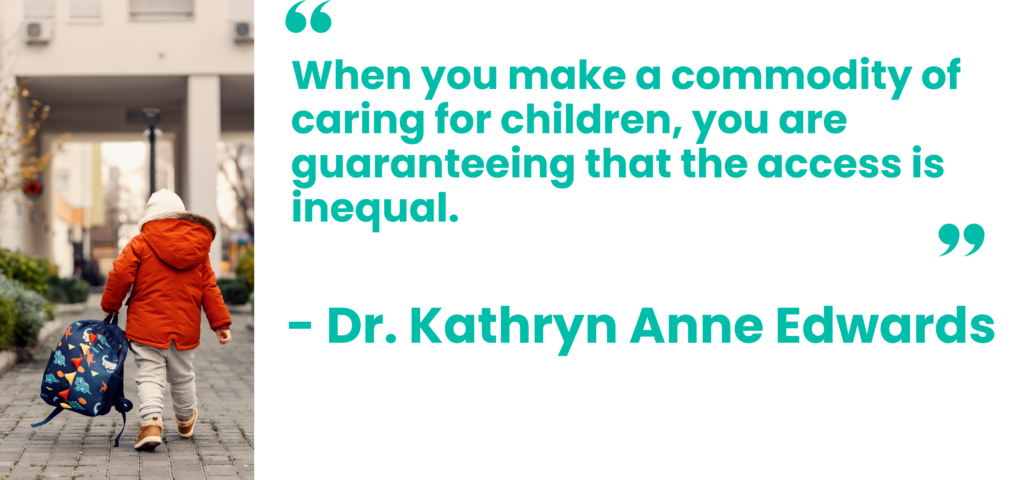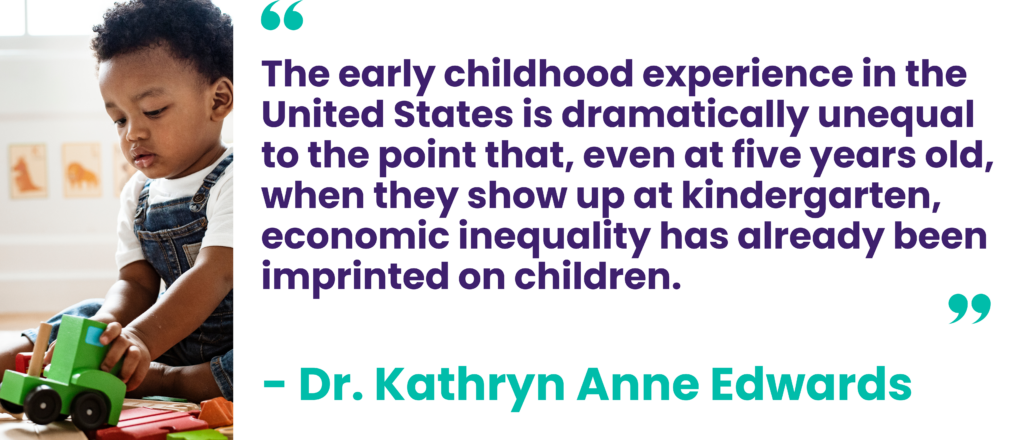
On July 11, Baltimore Regional Housing Partnership (BRHP) Executive Director Adria Crutchfield joined PhD economist and freelance economic policy consultant Dr. Kathryn Anne Edwards to discuss the childcare crisis in the United States as part of the ongoing BRHP In Conversation series designed to introduce relevant experts and information to stakeholders and community members. The main topics of the conversation included explanations of the root of childcare inaccessibility in the United States, the harmful effects of inadequate or absent childcare on mothers and children, the importance of investing in children, and potential solutions to this crisis. I was impressed by Dr. Edwards’ compelling explanation of the widespread impacts of expanding affordable childcare for families, women, and children – issues critical to BRHP’s work serving more than 4,300 families in their Housing Mobility Program, which includes nearly 8,000 children.

Dr. Edwards expertly described the foundation of what the national childcare crisis entails and who it harms most. In the United States, childcare is offered by a private market, Dr. Edwards explained, meaning childcare must be profitable; unfortunately, this market has been in decline and in failure for decades. She argued that the root of the childcare crisis is inaccessibility due to the commodification of childcare, “when you make a commodity of caring for children, you are guaranteeing that the access is unequal.” For example, “the price of childcare has risen faster, over the past 30 years, than medical care, housing, food, energy, and even prescription drugs,” and currently, “the average mortgage payment in the United States is less than the average childcare payment,” said Dr. Edwards, mentioning that it is often easier for families to purchase houses than secure quality childcare. I was surprised at this poignant comparison given BRHP’s extensive knowledge of housing market failures. The absurdly prohibitive costs of childcare make accessing it fundamentally unequal, “because we are selling high-quality early childhood development, and people who want to buy it can’t.”
Because of BRHP’s involvement in the housing market and related policies, I found the juxtaposition of the two markets especially intriguing. Dr. Edwards focused on a similar policy choice in the United States to rely on the free market to provide both resources. In both cases, the United States relies on the market to provide most of the supply while the government offers subsidies and direct services only at the margins. There are numerous policies the government could enact to improve the housing market supply and access; for example, the government could expand the Low-Income Housing Tax Credit (LIHTC) program, develop and fund more affordable housing and affordable mortgages, or even increase funding for housing vouchers to meet the actual need1 – but Dr. Edwards contended that while the housing market is large and functional enough to work with additional government investment, the same cannot be said for childcare.

The childcare market is a complete failure that must be entirely replaced with a new model that relies on government investment to ensure equal access to needed care. Unfortunately, Dr. Edwards remarked that there is no market solution for childcare, because there are no ways for quality childcare practices to evolve to be less resource-intense; “children need the eyes, ears, and attention of a capable adult. That is expensive, there is no other way to make it cheaper or more efficient,” Dr. Edwards explained. The housing market could easily produce sufficient housing supply at different price points, using various structures, and located across a city. Childcare, on the other hand, should be more equitable, meaning there should not be a massive price dispersion nor significant differences in these experiences since all children need and benefit from a baseline of early education.
I found Dr. Edwards’ point about the impacts of the childcare crisis on families, especially women in the workforce, extremely compelling; particularly how she linked gender roles in childcare and the labor market to the need for affordable, equitable, and accessible childcare. She framed the recent mass exodus of women from the labor market, due to historic discrimination and gender-based wage gaps, as a loss of years of income tax contributions. Access to quality affordable childcare allows parents and families to work more consistently – particularly mothers. It would allow them to increase their savings and disposable income without the restrictive cost of childcare, instead spending that money on other necessities, and to provide equitable access to early childhood interventions and education for all children. Dr. Edwards explained that “when kids enter kindergarten at age five, economic inequality has already been imprinted,” as demonstrated by the 30-40% of five-year-olds who are not prepared for kindergarten like their peers. If every child is part of an early educational program through affordable and equitable childcare, it is easier to catch developmental delays sooner. The economic benefits to early childcare are clear. High-quality care is an investment in children’s education and development that is a direct investment in the future workforce, and the current workforce by enabling parents to work and earn higher incomes that provide for improved family outcomes.
Dr. Edwards confirmed Adria’s suggestion that historical discrimination and racism keeping Black and Brown households out of the housing market and excluded from wealth-building endeavors extends to the childcare crisis. “Black and brown women are disproportionately affected,” Dr. Edwards stated, because “resources determine the quality of care,” and these groups have been denied necessary resources for decades, preventing access to adequate housing options and high-quality childcare alike.
Despite the grim nature of the childcare crisis and its harmful impacts, I was inspired and made hopeful by Dr. Edwards’ discussion of the beneficial models already in action at the state and local levels, and even among neighboring countries, from which the United States can draw. New Mexico added permanent funding for universal access to childcare in their constitution; although the supply has been insufficient for the demand, this model offers a good start to alleviating childcare concerns. D.C. provides universal access to early education and childcare for three to four-year-olds; however, D.C. is both a model and a cautionary tale, according to Dr. Edwards, since their programs upended the private childcare market for infants up to three years old, and they have the longest childcare waitlist and most expensive care across the nation. On the other hand, Canada utilizes a capped cost system, covering the remaining costs after parents pay a capped fee, allowing families to dictate their preferred type of care. This model makes the most sense for the United States to follow, suggested Dr. Edwards.
Ultimately, Dr. Edwards’ informative discussion made clear that the United States must recognize the connection between economic prosperity and access to childcare and make the needed investment to create a public childcare system for all, not only as an important public service but for the sake of the national economy.
1. “Due to severe underfunding, just one out of every four income eligible households receives the help it needs from federal housing assistance” (Mazzara, 2021). Out of Reach 2024 Report, National Low Income Housing Coalition (NLIHC)
Want to catch the full conversation? Take a moment to watch the full replay on our YouTube channel!
Written by — Jackie Rittenhouse, Communications and Special Projects Intern